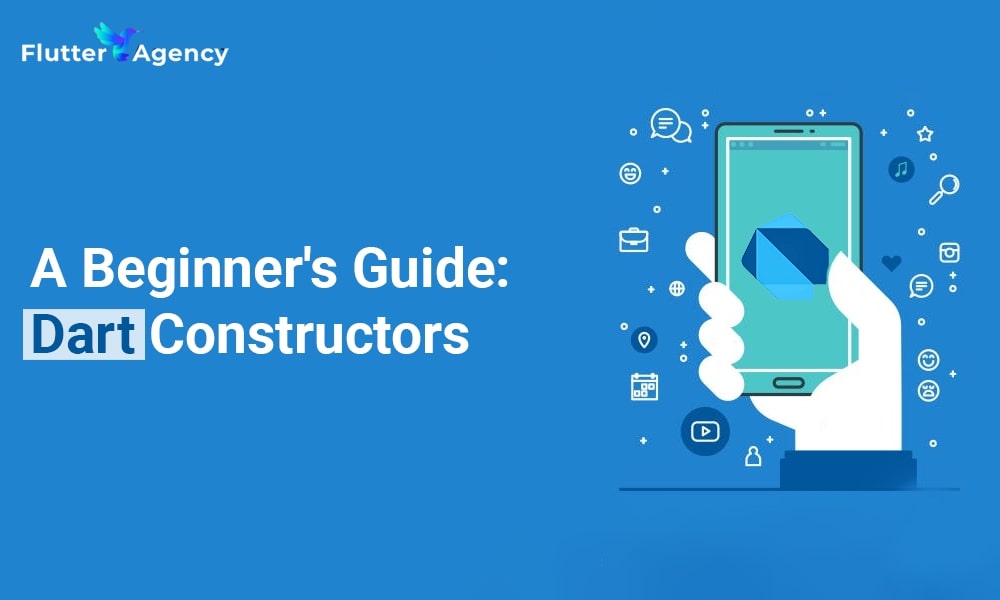A Complete Guide: Dart Constructors
You’ve come to the right place if you’re new to Flutter or want to learn the fundamentals of Dart programming languages to get started with app development. This blog post will go into great detail regarding constructors in Dart, including their types, applications, and anything else you need to know. So let’s get started.
Constructors are specialized methods used to create and initialize objects of a class in the Dart programming language. At the same time, a class is an outline or sketch containing the precise information or logic about an object you build.
Constructors play a significant role in object-oriented programming in most contemporary programming languages. Similar to other object-oriented programming languages, we make use of constructors. It provides developers with a few additional constructors called default constructors, factory constructors, and named constructors using Dart constructors.
class DefaultConstructorDemmo {
DefaultConstructorDemmo() {
print('Default Constructor called !!');
}
}
void main() {
final a = DefaultConstructorDemmo();
}
Essential Points for Dart Constructor Use
- The class name and the constructor’s name must match.
- Constructors are unable to return any values. You can use factory constructors to return any value.
- The compiler generates the default constructors if no constructors are defined in the class.
- Constructors cannot be inherited, and each class has its own constructors.
- Multiple named constructors can exist, but only one default constructor per class.
- Only the ‘new’ keyword or the abbreviated form ‘ClassName()’ can invoke constructors.
- Make sure that constructors and properties, where necessary, have names like “const” or “final.” You can use it to enhance security and performance.
How many types of Dart Constructors?
In Dart, constructors mainly fall under one of three categories. However, there are six kinds in total that we can utilize with constructors at certain times to carry out specific tasks.
Let’s investigate the various constructor types in Dart.
1. Default Constructors
A constructor that doesn’t take any inputs is the default. The Dart compiler will create a constructor if a class doesn’t already have one declared. The default values for all instance variables, which are “null” for reference types and “0” for numeric types, are initialized by default constructors.
class DefaultConstructorDemmo {
DefaultConstructorDemmo() {
print('Default Constructor called !!');
}
}
void main() {
final a = DefaultConstructorDemmo();
}
2. Dart Named Constructors
Since there can only be one constructor with a given name, we can offer the constructor a name by using named constructors. Dart provided a new constructor called “named constructor,” specifically for this use. These can be handy when you want different ways to make an object.
For instance, you may develop a constructor that initializes an object with car_name and car_color and another that initializes an object with just a name.
The “constructor” keyword, which will appear after the constructor’s name, can be used to define a named constructor in a class.
class NamedConstructorDemmo {
NamedConstructorDemmo.carName() {
print('Mercedes');
}
NamedConstructorDemmo.carColor() {
print('Red');
}
}
void main() {
final a = NamedConstructorDemmo.carName();
final b = NamedConstructorDemmo.carColor();
}
3. Dart Factory Constructors
Factory developers are those who build following factory design principles. They employ the constructor keyword “Factory.” As a result, the class is not created or provided in a new instance. Instead, depending on the argument stipulated, it either returns the current instance of the subclass or creates a new instance of the subclass. The return keyword is required for a factory constructor to return an object.
class FactoryConstructorDemo {
FactoryConstructorDemo();
factory FactoryConstructorDemo.toExample() {
return FactoryConstructorDemo();
}
}
void main() {
final e = FactoryConstructorDemo.toExample();
}

4. Constant Constructors in Dart
Constant constructors are another option in the Dart programming language. It implies you cannot change an object used to generate a class. The ‘const’ keyword is used to invoke the constructors for constants. The constant constructors require the initialization of object attributes with constant values.
class ConstantConstructorDemo {
const ConstantConstructorDemo(this.name, this.color);
final String name;
final String color;
void printProperties(){
print(name);
print(color);
}
}
void main() {
final a = ConstantConstructorDemo('mercedes', 'red').printProperties();
}
5. Parameterized Constructors
Parameterized constructors are used when parameters are passed to the constructor. Only one or more parameters are accepted by the parameterized constructors. When an object is formed, they are used to send values to its properties. Named constructors or default constructors are both possible for parameterized constructors.
class ParameterizedConstructor {
ParameterizedConstructor(String name) {
this.name = name;
print(name);
}
late String name;
}
void main() {
final e = ParameterizedConstructor('mercedes');
}
6. Redirecting Constructors
The constructors that call another constructor in the same class are called redirect constructors. The ‘: this ()’ notation is used to specify the redirect construct, whereas the ‘this ()’ notation calls the constructor.
class RedirectContructorDemo {
RedirectContructorDemo(this.name);
final String name;
factory RedirectContructorDemo.first(String name) {
return RedirectContructorDemo(name);
}
factory RedirectContructorDemo.second() {
return RedirectContructorDemo('Second');
}
printName() {
print(name);
}
}
void main() {
final a = RedirectContructorDemo.first('First').printName();
final b = RedirectContructorDemo.second().printName();
}
Use of this keyword constructor in Dart
The ‘this’ keyword in constructors is used to refer to the active instance of a class. When an object is created, it is used to initialize its properties. The ‘this’ keyword is used in the constructor body to transmit the constructor’s parameter values to the corresponding class properties.
Conclusion
All there is to know about Dart constructors. I hope you found this post beneficial. We frequently share helpful Flutter app development guides and content. On our blog, you can discover plenty of valuable details.
Understanding the function of constructors in Dart will help you build better, more effective code because constructors are an essential component of OOP in Dart. You can improve your code’s productivity, maintainability, and security by becoming an expert constructor developer.
Keep up with us to read more informative blogs about developing Flutter apps. Alternatively, you may hire Flutter developers to translate your intricate business concepts into realistic apps. I appreciate you being there.
Frequently Asked Questions (FAQs)
1. What does Dart flutter constructor mean?
The constructor is called when a class object is created. In object-oriented programming, creating an object is known as the constructor. Every class has a default constructor that the compiler creates when the class is called, and each class can also define its constructor.
2. What is the use of constructors?
Use constructors for the reasons listed below: We utilize constructors to initialize the object with its default or initial state. Default values for primitives might not always match the desired initial state. Using a constructor also provides information on dependencies.
3. Define the default constructor in Dart.
Default constructors and no-arg constructors are two terms for constructors without parameters. If we don’t declare it in the class, the Dart compiler will automatically generate it (without an argument). Whether we create a constructor with an opinion or without one, the Dart compiler ignores the default constructor.
1 comment
Leave a comment
Contemporary ventures
Recent blog
ready to get started?
Fill out the form below and we will be in touch soon!
"*" indicates required fields










Thnnnxxx.